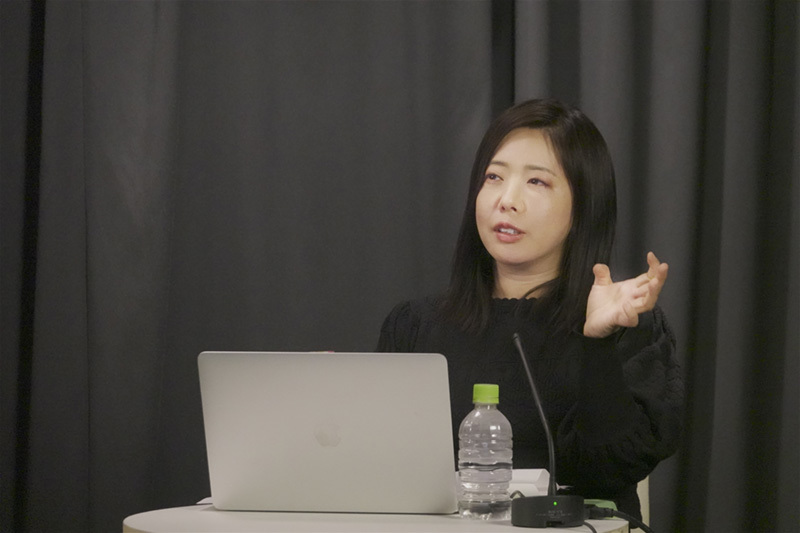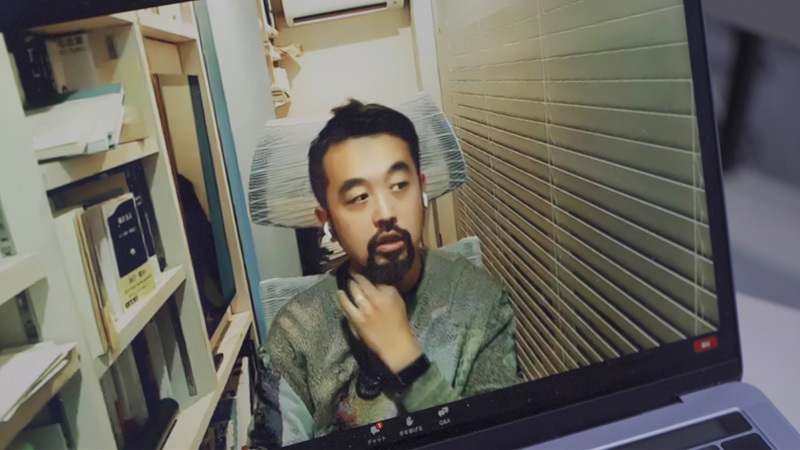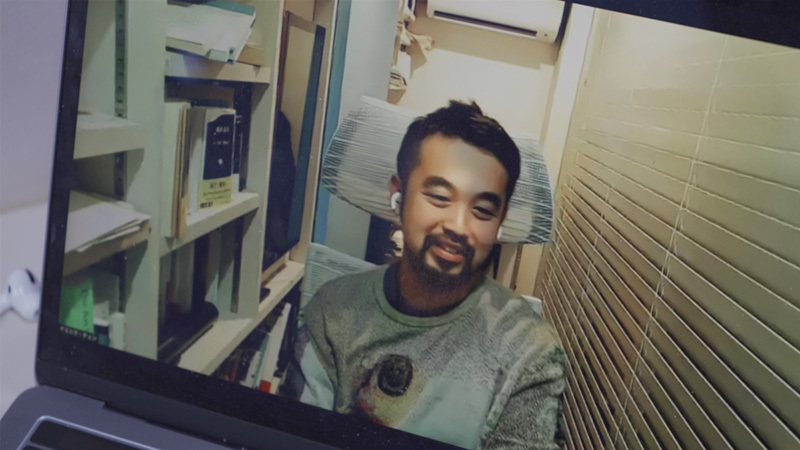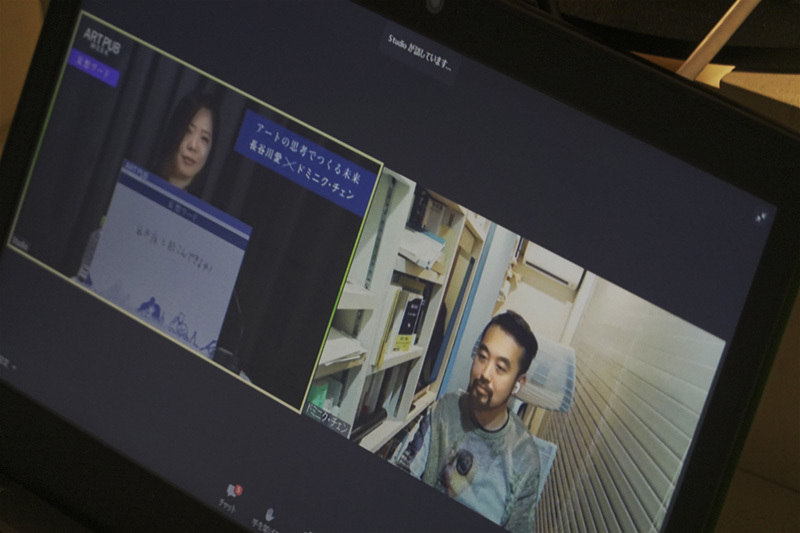Note: This website was automatically translated, so some terms or nuances may not be completely accurate.
What Future Emerges from Artistic Thinking? (Ai Hasegawa × Dominique Chen)
From December 7, 2020, a five-night webinar series titled "Nights of Imagining the Future Created by Art and Business" was held, hosted by Dentsu Art Hub, an internal Dentsu Inc. lab dedicated to "connecting art and business to envision a prosperous future." Each session featured dialogues and trialogues among powerhouses deeply involved in art and business from their respective standpoints, all conducted under "three keywords." The themes for these "fantasy talks," set in advance by the participants themselves, were enough to spark the imagination of the audience.
In this series, we aim to delve into the core themes revealed through the webinars: the essence of art, the essence of business, and the future created by the "multiplication" of these two forces, all from the unique perspective of our editorial team.
In this second installment, we delve into the future envisioned by artistic thinking, drawing from the dialogue between artist and designer Ai Hasegawa and researcher Dominique Chen.
Written by: Web Dentsu Inc. Editorial Department
"If Noh theater existed 400 million years ago during the Carboniferous period, what kind of performances would it have been?" (Ai Hasegawa)
Where exactly does this idea originate? As you read on, I believe it will gradually become clear. Tonight's conversation was once again worthy of the title "Night of Speculation."
Hasegawa's specialty is "Speculative Design." While design is typically seen as problem-solving and art as posing questions, she describes speculative design as designing alternative values and attitudes for raising issues and sparking debate—a departure from conventional design approaches. This speculative design apparently lacks any specific "method" or "〇〇 design" framework. For instance, when we hear terms like "art thinking," we might mistakenly assume it's some magical method that instantly solves society's problems. But that's not what it is.

Beyond the question introduced in the headline, Hasegawa also ponders this: "Sometimes, no matter how many words we use or how much we appeal to action, we just can't understand each other. What if we tried communicating with something as distant from humans as a shark?" Driven by this thought, Hasegawa created perfume to attract sharks. The true nature of "an attitude towards design" gradually becomes clear. A similar sentiment can be seen in the remarks of his conversation partner, Dominique.
"Actually, I'm currently enjoying conversations with my rice bran pickling bed." (Dominique Chen)
This too is an episode worthy of the title "Delusional Night Gathering." Like Hasegawa, Dominique is exploring the potential for communication with the unknown. His "conversation with the nuka bed" involves using a robot that translates the bed's condition into human language to understand its state.
Dominique's research specialty lies in communication using digital tools, and his passion for "translation" is extraordinary. A clear example is his installation work "Found in Translation," created with Google Creative Lab and Studio The Green Eyl, which simultaneously interprets over twenty languages. This project is a prime example demonstrating how the act of "translation" itself can become an "expression."

The subject of "translation" is not limited to foreign languages. It involves communicating across time and space with people from the past or even the future. Whether the other party is microorganisms living in a rice bran pickling bed or a mere pebble, attempting "translation" always leads to thrilling discoveries. Yes, Mr. Dominique says.
Tonight's Keyword (Part 1): The Boundaries of Family
Tonight's fantasy gathering has finally begun. The first theme is already intriguing. This stems from an episode during a workshop for Mr. Hasegawa's Shared Baby project, which explores the question: What if technology were developed to create children with not just two genetic parents (father and mother), but three, four, five, or more?
To contemplate the problems and joys awaiting families with children born through technology who have multiple parents, Hasegawa, Dominique, and two friends—four people in total—performed a three-hour improvisational simulation based on the premise of creating two children. They wrote potential happy events and troubles for the family on several cards each, shuffled them, and then, drawing one card at a time from the pile, acted out each event as the children grew to adulthood. Through this process of drawing and acting, they created a family history spanning 20 years.
"It was a quiet shock, or rather, a strange experience where a vague, lingering feeling persisted for two whole months after the workshop ended," recalls Dominique. According to Hasegawa, the three hours were spent calmly conducting peculiar experiments: What would happen if the parental rights for the child born to the four of them were divided into four parts? Who would decide the child's name, and how?
What's fascinating is that they even went so far as to create a fictional legal document called a "Child Sharing Agreement." "I've kept this a secret until now because it's embarrassing, but I started feeling like Dominique's real daughter was my own child. Thinking about that, it made me wonder: where exactly is the boundary between being family and not? One fantasy led to another, and I had some strange discoveries,"
To Hasegawa's words, Dominique replied, "That, I think, is precisely the power of 'pretend play.'" Considering how "family relationships" in the real world are weakening or becoming distorted, in a sense, 'pretend' can be far deeper than reality and holds the potential for all sorts of discoveries.

Tonight's Keyword (Part 2): more-than-human (life forms beyond humans)
"This might be a bit of a leap," Mr. Hasegawa began as soon as the second keyword was presented. "I'm studying Noh theater to create a new work with Noh performers. Apparently, Noh includes plays dedicated to the gods. That means the gods are the audience, right? If Noh existed in the world 400 million years ago, what kind of plays might have been performed there? What kind of gods would we have discovered if we had been in that 400-million-year-old world?" That is the question Mr. Hasegawa posed, introduced in the first heading of this article.
Mr. Dominique, who receives personal training from a Noh performer, responds to Hasegawa's question: "Noh features many more-than-human beings—earth spiders, ghosts, demons, the demon child Shuten-dōji. What's fascinating is that conversations between these beings and the traveling monk often break down. They might refuse to answer questions like 'Who are you?' But in the end, a kind of mutual understanding is established. This is incredibly interesting and inspiring. It shows we can connect with non-human entities through means beyond what humans consciously decide."
Within the framework of "de-anthropocentrism," Hasegawa also takes an interest in the pros and cons of anthropomorphizing animals. For instance, he argues that dismissing the idea of pandas speaking as mere fantasy is a huge mistake. The very act of making pandas speak human language reveals how rigidly we're bound by anthropocentric thinking. For Hasegawa, the significance of art lies in its ability to liberate us from such shackles.
Dominique's "Talking Rice Bran Bed" isn't about the act of making it speak. Dominique says that through the process of trying to connect with microorganisms that lack a nervous system, the invisible becomes visible. "For example, what if there were a rice bran bed-type society, or a rice bran bed-type family? Thinking like that evokes a strange sensation, one that lets you perceive human society from a different perspective." Beyond that lies a thrilling fantasy, one that seems to hold the treasure capable of setting humanity free.

Tonight's Keyword (Part 3): Tech Hippie
Tonight's theme has one final keyword. The final keyword from Mr. Hasegawa is "Tech Hippie." "This word was requested by Dominique," says Mr. Hasegawa. "I actually wanted to say 'Nomadic Tech Hippie,' but it was a bit long, so I shortened it to Tech Hippie." The conversation seems to be shifting towards nomads. "The most important aspect of the hippie mindset is creating community while also moving, continuing to move."
The hippies who swept the world during the postwar chaos. Eventually, they underwent a process of becoming hollowed out, like the rise of the yuppies, and connected to the tide of digital technology. What flows through this is the ideology and code of conduct of anti-establishment. However, as the world created by digital technology and SNS begins to surpass the established system, the core of hippie-like ideology becomes hollowed out. Because even if you want to rebel, the very system you're rebelling against has become fragile. "As we navigate the future alongside pandemics like COVID-19 and natural disasters caused by climate change, isn't there a need right now, at this very moment, to reconnect hippie-like ideology with technology?" The future Dominique envisions is rooted in cool, meticulous analysis.
At the end of the conversation, the two exchanged views on the concept of "ownership." Dominique states, "I've lived alongside nomadic people, and what struck me most was how radically different their concept of ownership is. They share astonishingly much, even with tourists. Being around them makes asserting ownership—like saying 'this is my land'—feel somehow petty." Technological advances have finally made our society conscious of the concept of "sharing." However, they had recognized its importance long before us.
Mr. Hasegawa also holds a "dehumanized, liberated perspective" on the concept of rights. "For example, movements are emerging globally to grant voting rights to the deceased, to recognize the right of future generations yet to be born to live in the present, or to confer personhood on rivers. This might stem from a sense of atonement for how our current legal frameworks and everything else are inevitably centered on humans living today. But in a nutshell, I think it boils down to this: 'Humanity alone can no longer bear the weight of this world.'"

Mr. Hasegawa's work can be found here.
Details on Hasegawa's workshop "SHARED BABY" can be found here.
Video of Dominique's "Found in Translation" is here.
This series is edited from the content of the webinar titled "A Night of Imagining the Future Created by Art and Business," supervised by Kentaro Kasama (President, Arts & Brands Inc.), organizer and head of Dentsu Art Hub, and presented from Web Dentsu's unique perspective.
Was this article helpful?
Newsletter registration is here
We select and publish important news every day
For inquiries about this article
Back Numbers
Author

Kentaro Kasama
Arts & Brands Co., Ltd.
President and CEO
After joining Dentsu Inc., he worked in the Marketing Division and Sales Division before joining the Planning Section in 2001, where he has remained ever since. As an integrated planner/director, he provides solutions to clients across various industries by planning holistically and neutrally—from upstream areas like business strategy, marketing strategy, and branding to output areas like creative and campaigns—to solve client challenges. In recent years, he has particularly focused on implementing "Content Solutions"—collaborating with content and media in the broadest sense to solve corporate and societal challenges. He <a href= "https://newhorizoncollective.com/" >joined New Horizon Collective</a>, G.K. in 2021. He is currently the Representative Director of Arts & Brands.



